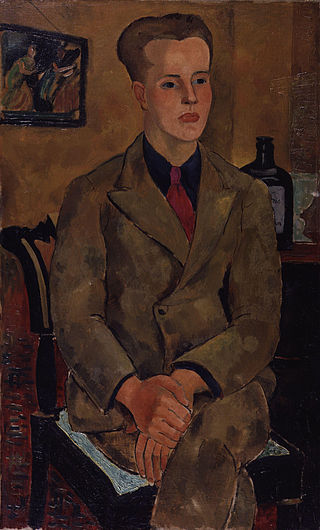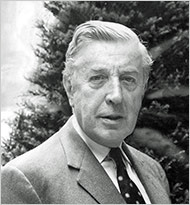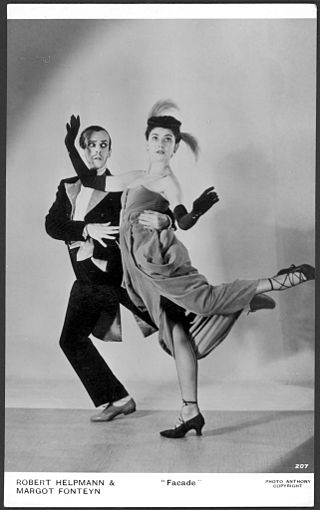Related Research Articles

In Greek mythology, Tiresias was a blind prophet of Apollo in Thebes, famous for clairvoyance and for being transformed into a woman for seven years. He was the son of the shepherd Everes and the nymph Chariclo. Tiresias participated fully in seven generations in Thebes, beginning as advisor to Cadmus, the founder of Thebes.

Leonard Constant Lambert was a British composer, conductor, and author. He was the founding music director of the Royal Ballet, and he was a major figure in the establishment of the English ballet as a significant artistic movement.

Sir Frederick William Mallandaine Ashton was a British ballet dancer and choreographer. He also worked as a director and choreographer in opera, film and revue.
John Arthur Lanchbery OBE was an English-Australian composer and conductor, famous for his ballet arrangements. He served as the Principal Conductor of the Royal Ballet from 1959 to 1972, Principal Conductor of the Australian Ballet from 1972 to 1977, and Musical Director of the American Ballet Theatre from 1978 to 1980. He continued to conduct regularly for the Royal Ballet until 2001.

Isabel Rawsthorne, also known at various times as Isabel Delmer and Isabel Lambert, was a British painter, scenery and costume designer, and occasional artists' model. During the Second World War she worked in black propaganda. She was part of an artistic bohemian society that included Jacob Epstein, Alberto Giacometti and Francis Bacon.

Les biches is a one-act ballet to music by Francis Poulenc, choreographed by Bronislava Nijinska and premiered by the Ballets Russes on 6 January 1924 at the Salle Garnier in Monte Carlo. Nijinska danced the central role of the Hostess. The ballet has no story, and depicts the random interactions of a group of mainly young people in a house party on a summer afternoon.
Horoscope is a ballet created in 1937 by Frederick Ashton with scenery by Sophie Fedorovitch and music by Constant Lambert. It is based on astrological themes, and is reminiscent of Gustav Holst's The Planets in its musical exploration of the mystical.
Les Rendezvous is a plotless one-act ballet created in 1933, with choreography by Frederick Ashton to the music of Daniel Auber arranged by Constant Lambert and with designs by William Chappell. It was the first major ballet created by Ashton for the Vic-Wells company.
Alexander Marshall Grant was a New Zealand ballet dancer, teacher, and company director. After moving to London as a young man, he became known as "the Royal Ballet's most remarkable actor-dancer in its golden period from the 1940s to the 1960s."
A Month in the Country is a narrative ballet created in 1976 with choreography by Frederick Ashton, to the music of Frédéric Chopin arranged by John Lanchbery. It is based on the play by Ivan Turgenev of the same name, and lasts for about 40 minutes.
Les Patineurs is a ballet choreographed by Frederick Ashton to music composed by Giacomo Meyerbeer and arranged by Constant Lambert. With scenery and costumes designed by William Chappell, it was first presented by the Vic-Wells Ballet at the Sadler's Wells Theatre, London, on 16 February 1937. It has been called "a paradigm of an Ashton ballet, perfectly crafted with a complex structure beneath the effervescent surface."
Jazz Calendar is a ballet created in 1968 by Frederick Ashton to the music of Richard Rodney Bennett. The ballet was first performed on 9 January 1968 by The Royal Ballet at the Royal Opera House, Covent Garden, with designs by Derek Jarman. The work was performed over 50 times up to 1979 by the Royal Ballet at Covent Garden but is not part of the current repertoire. It was also produced in October 1990 at the Birmingham Hippodrome by Birmingham Royal Ballet.
Hubert John Clifford was an Australian-born British composer, conductor and musical director for films.
The Wise Virgins is a one-act ballet based on the biblical Parable of the Ten Virgins. It was created in 1940 with choreography by Frederick Ashton, to a score of music by Johann Sebastian Bach orchestrated by William Walton.

Façade is a ballet by Frederick Ashton, to the music of William Walton; it is a balletic interpretation of items from Façade – an Entertainment (1923) by Walton and Edith Sitwell. The ballet was first given by the Camargo Society at the Cambridge Theatre, on 26 April 1931. It has been regularly revived and restaged all over the world.
Symphonic Variations is a one-act ballet by Frederick Ashton set to the eponymous music of César Franck. The premiere, performed by the Sadler's Wells Ballet, took place at the Royal Opera House, Covent Garden, on 24 April 1946 in a triple bill; the other works were Ashton's Les Patineurs and Robert Helpmann's Adam Zero. The ballet was conducted by Constant Lambert and the set designed by Sophie Fedorovitch.
The Camargo Society was a London society which created and produced ballet between 1930 and 1933, giving opportunity to British musicians, choreographers, designers and dancers. Its influence was disproportionate to its short life. Dame Ninette de Valois, founder of The Royal Ballet, saw it as "having done much for the cause of English ballet", and Encyclopædia Britannica Online credits it with "keeping ballet alive in England during the early 1930s". The society was named after the eighteenth-century French dancer Marie Anne de Cupis de Camargo.
Desmond Doyle was a South African ballet dancer who performed in England in the 1950s and 1960s before becoming ballet master of The Royal Ballet.
Brian Shaw was a British ballet dancer and teacher. As a leading dancer with the Royal Ballet during the 1950s and 1960s, he was widely regarded as "one of the finest classical male dancers of his generation".
References
- 1 2 3 Alexander Bland, The Royal Ballet: The First Fifty Years. London: Threshold Books, 1981, p286.
- 1 2 Motion, Andrew. The Lamberts: George, Constant & Kit, Chatto & Windus, London, 1986, p250-251.
- ↑ Stephen Lloyd: Constant Lambert: Beyond the Rio Grande, Boydell Press, 2015
- ↑ Reprinted in Buckle, Richard. Adventures of a Ballet Critic (1953)
- ↑ Kavanagh J. Secret Muses: The Life of Frederick Ashton. Faber & Faber Ltd, London, 1996, p390-392.
- ↑ New York Times, 17 September 1955, p 13
- ↑ John M. Belcher. Notes to Naxos CD 8.555959 (1992)
- ↑ David Vaughan, Frederick Ashton and His Ballets, revised edition (London: Dance Books, 1999), Synopsis p. 423.
- ↑ Lewis Foreman. Recording British Music, Vocalion Books (2024), p. 251
- ↑ BBC Genome Project
- ↑ Foreman, L. Booklet essay accompanying Hyperion CDA67049. London, 1999.